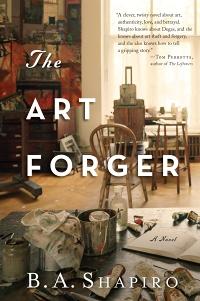 What is real, and what is fake? How important is the identity of an artist to the work of art itself? These are the questions explored by B.A. Shapiro in her absorbing new novel, The Art Forger. If you know nothing about art, you’ll be fascinated by this intimate glimpse into the techniques of both master painters and forgers, as well as the high-stakes, image-conscious world of major museums and galleries. And if you’re addicted to the decidedly lowbrow and mean-girls-times-a-thousand drama of Gallery Girls, as I am, consider The Art Forger required reading.
What is real, and what is fake? How important is the identity of an artist to the work of art itself? These are the questions explored by B.A. Shapiro in her absorbing new novel, The Art Forger. If you know nothing about art, you’ll be fascinated by this intimate glimpse into the techniques of both master painters and forgers, as well as the high-stakes, image-conscious world of major museums and galleries. And if you’re addicted to the decidedly lowbrow and mean-girls-times-a-thousand drama of Gallery Girls, as I am, consider The Art Forger required reading.

Related Update, Oct. 16: Major art theft from Dutch museum. Thieves broke into Kunsthal museum on Tuesday and walked off with works from the likes of Picasso, Monet, Gauguin and Matisse potentially worth hundreds of millions.
Claire makes a living painting copies of masterworks for Reproductions.com. Everything changes when a major gallery owner comes to her with a strange request–to make a copy of the Degas masterpiece After the Bath so convincing that it can be passed off as the real thing and sold to an anonymous buyer. The original was stolen from the Gardner Musuem in Boston in 1990 (this part of the story is true; the theft was part of a $500 million dollar heist that still has not been solved). When Claire accepts the deal, whose purpose is supposedly to restore the original, stolen Degas to the Gardner, she finds herself living in the presence of a painting that inspired her as a young girl. By the time Claire begins to wonder about the provenance of the painting she has been commissioned to copy, things have already begun to spiral out of control.
I found the most interesting plot line to be the back story involving Claire and her former teacher and lover, Isaac Cullion, whom she rescued from obscurity by making an enormous personal sacrifice. Cullion’s rejection of Claire after she catapults him from nobody to art-star is a cautionary tale for any young creative type who sacrifices her own work on the alter of the male ego. Reading this novel, I couldn’t help see the parallels to the literary world–both in the feverish pace of Claire’s work and in the arbitrary nature of fame and financial success.
An interesting side note about the author: The B. in Shapiro’s name stands for Barbara, and Publishers Weekly has an interesting article on the missing first name on the cover of the book:
To support The Art Forger, one of its fall lead titles, Algonquin printed 3,000 galleys, which it began distributing at BookExpo America earlier this month. On them it omitted any reference to Shapiro’s first name or her previous books, published between 1993 and 2002: five suspense novels and one nonfiction…The press sent out invitations from the fictional art gallery in the book, Markel G, to view the recovered Degas, which plays a central role in the story. The hoax was so convincing that at least one bookseller communicated her excitement at seeing the impressionist painting unveiled in the Workman booth…
It was a smart move on Algonquin’s part. The sad truth is that an author is only as good, in the eyes of the publishing world, as the sales of her last book. Positioning mid-list author as a debut author is a good way to get her a lot more attention from reviewers and booksellers. The fact that the novel itself is about a hoax makes the ploy all the more delightful.
David Allan Barker discusses this issue eloquently over at nouspique, in his reaction to Ian Jack’s attempted killing-off of Albanian writer Jiri Kajane in the Guardian. (Jack’s editorial takes aim at the authors of Winter in Tirane, a “translation” of Jiri Kajane’s short stories published last year by my own literary labor of love, Fiction Attic. Press.)
Is Winter in Tirane any less appealing because it was written by two guys from Northern California, instead of by the fictional Kajane? Is The Art Forger any less engaging for the fact that the author has several books under her belt? In both cases, the answer is no. The fact that Shapiro has been a working writer for so long makes me more likely to read the book–not less likely. Shapiro’s novel, like Jiri Kajane’s short stories, is an astute commentary on the obsession with origin: our cultural tendency to elevate a work to high status depending not upon its quality, so much as upon the identity of its creator.
For further reading: real-life art forger Ken Perenyi sells his own masterpieces as fakes, via the New York Times.
Reviewed by Michelle Richmond, New York Times bestselling author of The Year of Fog.
Stay tuned for these reviews: The Not Yet, by Moira Crone, and Love’s Winning Plays, by Inman Majors
